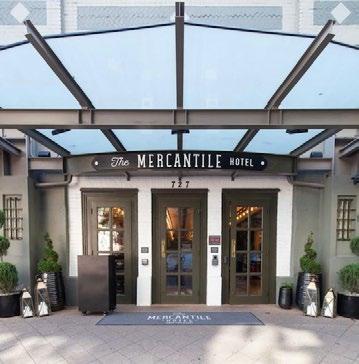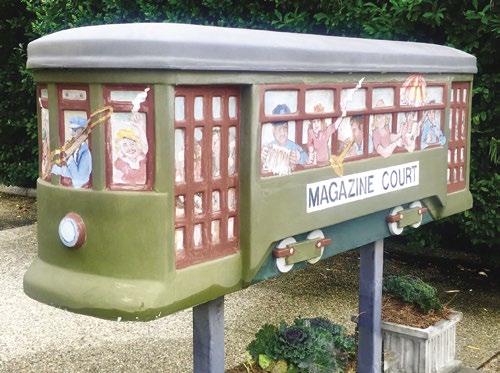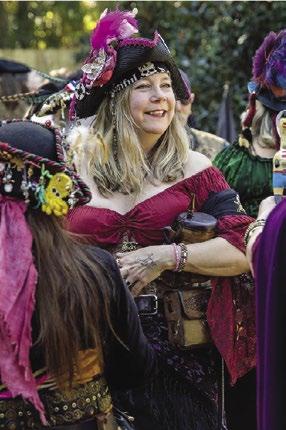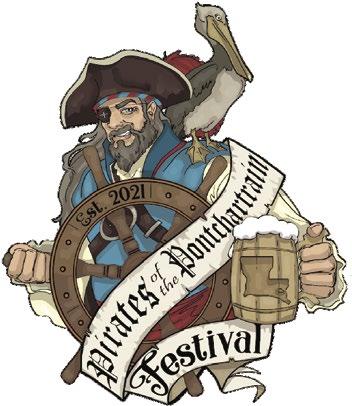
11 minute read
Street Cars' Next Stop: History
NEXT STOP: HISTORY

The ability of the iconic New Orleans Streetcar
to Capture Riders' Imagination Rattles On You’re in your car going down St. Charles Avenue. The sun is shining through the leaves on the live oak trees that flank the By Burke Bischoff thoroughfare. Maybe you’re going to Superior Grill for lunch, commuting Classic city streetcars streetcars, old to Loyola for classes, or just cruising to some jazz on WWOZ. As you’re driving, the and new St. Charles Avenue Streetcar comes from up behind on your left side, packed with locals and tourists. As you see it rumbling past, you might think nothing of it. You’ve seen that dark green streetcar so many times, it just seems to blend into the avenue’s beautiful scenery. In your mind, that streetcar is part of what completes your mental image of “New Orleans.”
New Orleans’s streetcars, or trolleys if you’re from out-of-town, have been an important part of the city’s public transit system since all the way back in the 1830s. In particular, the St. Charles Streetcar line has the distinction of being the oldest continuously functioning streetcar line in the entire world (since 1835) and is a registered National Historic Landmark. Currently, the city has five lines that are managed by the New Orleans Regional Transit Authority: the St. Charles line, two branches of the Canal line (one heading to Metairie Road and the other towards Bayou
St. John), the Riverfront line, and the RampartSt. Claude line.
According to the book The Streetcars of New Orleans by Louis Hennick and Harper Charlton, the first rail service to appear in the Greater New Orleans area was in 1831 when the Pontchartrain Railroad Company created a five-mile line along Elysian Fields Avenue toward Lake Pontchartrain. The original cars on this line, plus many other lines that opened in the city, were pulled by horses until they were eventually replaced with steam engine cars starting in 1832. When the New Orleans and




Carrollton line was completed and opened in 1834, New Orleans became the second city in the world to have a proper and working street railway (the first being New York City). By the late 1800s, six separate streetcar companies were servicing a multitude different lines around the city.
As New Orleans continued to expand and urbanize, steam powered streetcars were eventually replaced with electric powered ones in 1893 and the six companies started consolidating into one privately-owned company, going by many names like the New Orleans Traction Co., the New Orleans Railways Co., and New Orleans Public Service Incorporated. Importantly, according to RailwayPreservation.com, 1923 was when the 900 Series Perley A. Thomas Car Works streetcars (aka the green streetcars that the St. Charles line still uses) were first introduced to the city. From the 19th to 20th centuries, New Orleans had 235 miles of track and more than 20 streetcar lines shipping residents all over the city like the Street Railway, Division 194, went on strike for four months and left over a thousand union streetcar workers without any income. Moved by this, the owners of Martin Brothers’ Coffee Stand and Restaurant would give these workers free baguette sandwiches during the strike. Supposedly, anytime a worker would enter their restaurant, the owners would yell, “Here comes another poor boy!” Thus, New Orleans’s first po-boys were born.
The heyday of New Orleans’s, as well as America’s, streetcars slowly started to fade in the early to mid-20th century when bus services became more popular. Really beginning at the end of World War II, this shift in focus with public transportation resulted in most of the city’s streetcar lines being discontinued or abandoned beginning in the 1930s to the late 1950s. Even the Canal line that locals are used to nowadays switched to bus service back in 1964. The St. Charles line was the only line that was able to escape this great streetcar purge.
The age of streetcars in New Orleans
Home of the Cotton Candy Cocktails

The Bar Is Open! Happy Hour 6pm – 9pm Thursday – Saturday


CELEBRATING 30 YEARS
CRAWFISH BOILS ARE BACK! ARE BACK!

Every Wed., Fri., & Sun. @ 4 pm
TRIVIA THURSDAYS
W/ DJ STACHE 6-9 PM LIVE MUSIC
FRIDAY 6-9PM OUTDOORS
RESTAURANT IS OPEN LATE 7 DAYS A WEEK • 11AM - 11PM 3449 River Road at Shrewsbury in Jefferson 834-4938



Red streetcars run along the Canal Street and Riverfront lines
Napoleon line, the Esplanade line, and the Desire line (made famous by Tennessee William’s most popular play A Streetcar Named Desire) My great-great-grandfather, Peter Jacob Weitzel, actually operated the streetcar on Dauphine Street for the New Orleans Railway and Light Co. until his death in 1905.
The streetcars were actually at the center of some major social changes in the city. In 1867, two years after the Civil War, an African American man named William Nichols was forced out of a white-only streetcar, which caused mass protests in the New Orleans. It was then decided that the streetcars would become integrated in order to avoid any violence the city had previously seen because of the war. This decision lasted until 1902 when the Louisiana legislature enforced racial segregation again, which itself didn’t get over turned until 1958.
There were also a number of labor strikes associated with the streetcars. Probably the most famous one was the strike of 1929, where employees of the Amalgamated Association of Electric was looking gloom until 1979 with the creation of the New Orleans Regional Transit Authority (or RTA, as locals know it by). This is the change that turned everything around. Working as a public body, and with the help of tax money and federal funding, RTA was able to create the Riverfront line in 1988 and reopen the Canal line in 2004 with newer, more comfortable red streetcars. Things looked dire in 2005, however, when Hurricane Katrina hit the city. While many of the city’s tracks and the new red streetcars were damaged, the St. Charles green cars made it through unscathed and were used on the available tracks as repairs were being done to the city in the following years.
It’s this resilience that helps make New Orleans’s streetcars so iconic. They have survived through strikes, natural disasters, and, hardest of all, innovation and modernization. These cars are just like the New Orleanians that they transport every single day. No matter what happens to them, they keep carrying on, full of color and grace.
Cutting Edge Theatre

April 9 —April24
Friday & Saturday at 8 pm Sunday Matinee at 2 pm
Please check web for Sunday matinee
767 Robert Blvd // Slidell, LA 70458 985-649-3727 // cuttingedgetheater.com
Tickets Starting at $25.00
Reservations strongly advised
We are adhering to all covid guidelines


Streetcars have become an almost synonymous image of the city of New Orleans with the likes of the fleurdi-lis and shotgun houses. This is even more true in a post-Hurricane Katrina New Orleans. While most of the city’s streetcars were damaged, some survived and were able to keep rolling as the city rebuilt itself. It was this sense of resilience in mind that gave birth to the Young Leadership Council’s A Streetcar Named Inspire project. This project, which sent 75 custom painted, locally sponsored streetcar sculptures across the city in 2008, helped a beaten down city raise its spirits after Katrina. These fun and colorful streetcars are a fitting match to the people who call New Orleans home.
For more information, please read "Plein Air Art Redefined" about New Orleans Public Art on page 24. For a complete list of the streetcar locations, please visit our Where Y’at Magazine’s website. Good News Express by Chris Kaiser Lafayette Seatcar Line by Jon Siebert Washington Square Park 300 Lafayette St. French Market Greetings by Will Smith, Jr. Meals On Wheels by Linda Lesperance French Market 650 Poydras St. Eyewitness Cruise by WWL Studios staff artist Hot Pepper Express by Ann Strub, Charles Bendzans, 1204 N. Rampart St. and Bobby Zabler – 601 Poydras St. Café Du Monde and Beignets by Steve Mickel Creative Energy on Track by Rontherin Ratliff & Café Du Monde, 1039 Decatur St. Jourdan Barnes – 701 Poydras St. Proud to Call it Home by Chris Kaiser Laissez Le Bon Temps Roulez by Kathy Miller Stone Jackson Square Inside 701 Poydras St. Lest We Forget–Girls First Hearts by Mackenzie The Flavor of New Orleans by Lori Gomez Thorpe – Jackson Square Lafayette St. at St. Charles Ave. Vieux Carre by Louis Colmonares All Aboard by Shirley Rabe Masinter 601 Chartres St. Stone Pigman, 546 Carondelet St. Louisiana History Comes Alive by Anna Hilderbrandt Downtown in Motion by Lori Gomez 533 Roayl St. 833 Poydras St. Throw Me Something Mister! By Gerry Claude We the People by Laxman Kewalramani Audubon Aquarium of the Americas 909 Poydras St. Metamorphosis: Journey of a Lifetime by Kim Hands Across the Water by Dennis Procopio Griffin – 1 Canal St. 909 Poydras St. Streetcar Full of Jazz by Sandra Samuel Carnival Time by Jordan Ivanov 1201 Canal St. 639 Loyola Ave. The Heartbeat of New Orleans by Karen Staklum The New Orleans School Bus by Jason Chaffin 1415 Tulane Ave. 639 Loyola Ave. (inside lobby) Ride the Wave by David Wargo Hear the Buzz by David Wargo – 1250 Poydras St. 1430 Tulane Ave. Ecology Streetcar by Tracey Jackson Southern Comfort by John Lamouranne 1250 Poydras St. 208 Bourbon St., on balcony New Orleans Sportscar by John Lamouranne A Streetcar Named New Orleans by Laura Cotoya Poydras St. and Sugar Bowl Dr. 925 Common St. Who Dat? By Alex Beard A Streetcar Named Maison Blanche by Mark Superdome, 1500 Poydras St. Schroeder – 921 Canal St. Jazzy Peacock by Yvette Creel – 1615 Poydras St. Mardi Gras Time by Louis Colmonares D’autres Mangent Pour Vivre; Nous Vivons Pour Inside Astor Hotel, 739 Canal St. Manger by Lori Gomez All That Jazz by Louis Colmonares 900 Convention Center Blvd. 622 Canal St., in window Patrick F. Taylor Streetcar by Lori Gomez Greetings From New Orleans by Steve Ulness Lee Circle Sheraton Hotel, 500 Canal St. Fleur de Lis by Louis Colmenares Big Money by Chris Kaiser – Harrahs Casino 2020 St. Charles Ave. Perley’s Barnyard Party by Paulette M. Lizano Through the Gate by McGehee School Canal Place Office Tower, 365 Canal St. 2336 St. Charles Ave., Alumni House Republic Sponsored Streetcar by Will Smith, Jr. Superior Spirit by Victor Ortiz 534 Gravier St. 3636 St. Charles Ave. Fleur de Trolley by Jacques Solulas Jazzy Ride by Gerry Claude Whitney Bank, 228 St. Charles Ave. 3806 Magazine St. They All Ask For You by John Lamouranne St. Charles and Napoleon 201 St. Charles Ave. 4330 St. Charles Ave. A New Orleans Reflection by Tina Mosley Strength and Beauty of Community by Hugo and Lis 201 St. Charles Ave. Kahn – 5342 St. Charles Ave. The Agony and The Ecstacy by Ayo Scott Streetcar Named Desire by Will Smith, Jr. Inside Stella Jones Gallery, 201 St. Charles Ave. Prytania Theater, 5339 Prytania St. New Orleans: Birth of Jazz by Susan Scott The Bottlecaps by Dr. Bob Hibernia Building, 313 Carondelet St. Whole Foods, 5600 Magazine St. Reflections of the City by Reggie Ford Southern Charm by Lori Gomez Inside Hilton Riverside Hotel, 2 Poydras St. Audubon Park, 6800 block of St. Charles Ave. We Are All Colorful by Barbara Shaw Class of 2008 by Shelly Jenkins Poydras St. and Camp St. Loyola University New Orleans Quad Simply Devine: Famous Culinary Queens from Both Only in Tulane, Only in New Orleans by John Sides of the Mississippi by Lori Gomez Lamouranne – Tulane University, McAlister Dr. Fulton St. at Poydras St. Little Me by the Artisans and Craftsmen of RTA New Orleans Musician’s Express by Linda Carrollton Ave. at Claiborne Ave. Lesperance – 400 Poydras St. Le Vie Abondante de Louisiane by Lita Ducote 4227 Canal St. (balcony) There’s No Place Like Home by The Magnolia School – 766 Harrison Ave. Lakeview Special by Louis Colmonares – Dominic Catholic Church, 755 Harrison Ave. The Lakeview Special by Linda Leperance – Canal Blvd. and Harrison Ave. My New Orleans by Frankie De Melo 111 Veterans Blvd. (lobby) Raven by Monica Tyran MSY (between C and D terminals)















